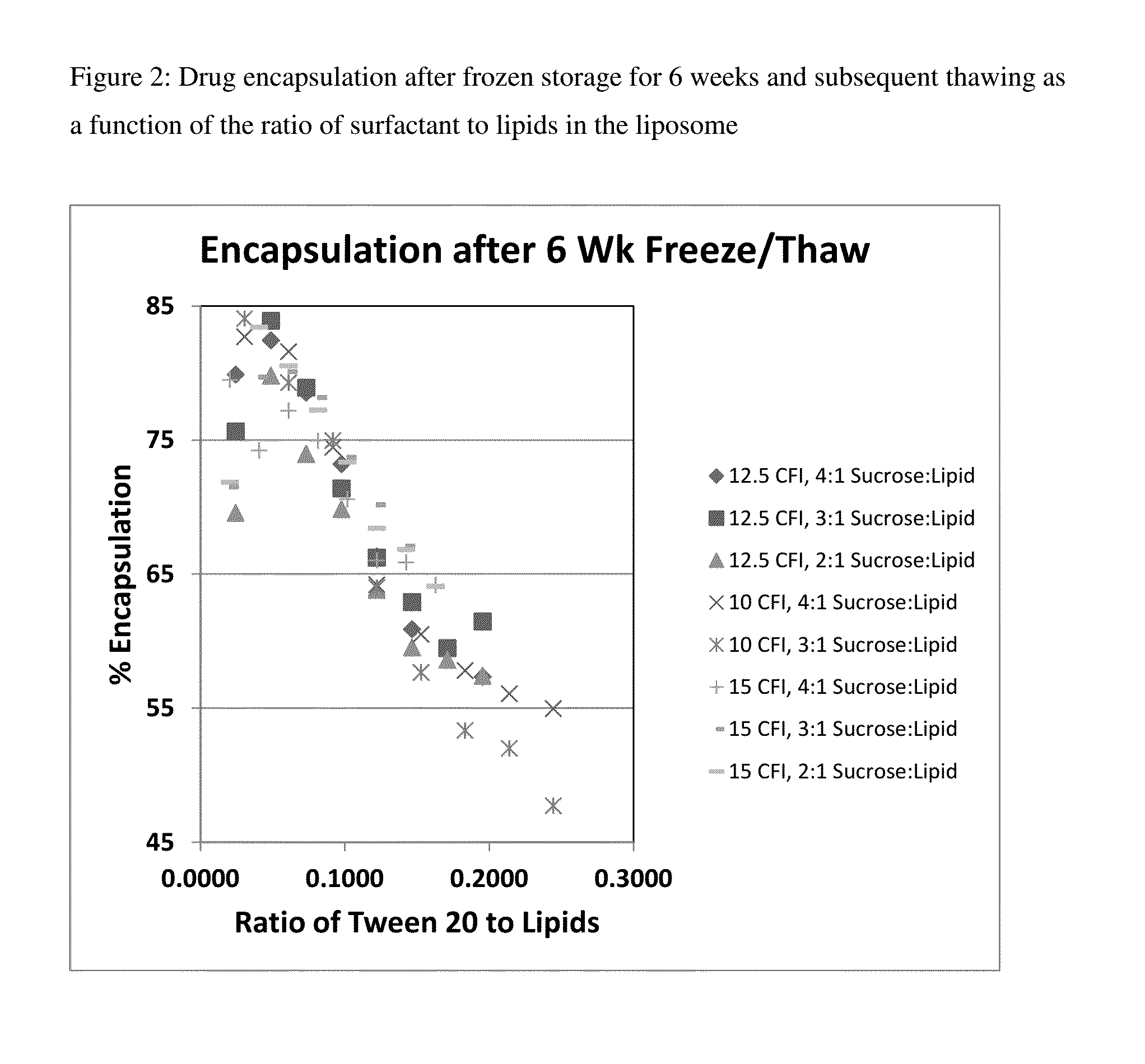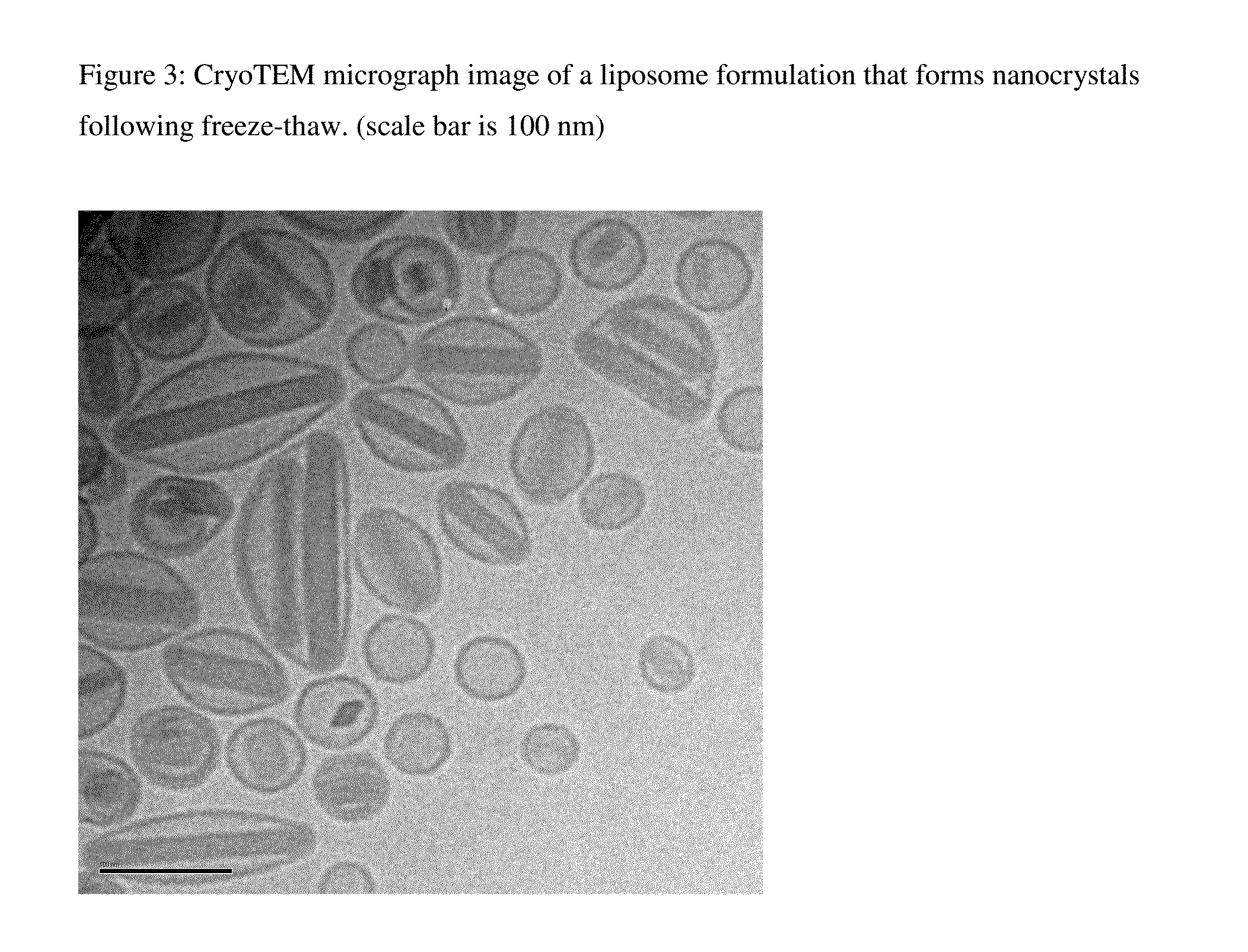Novel liposomal formulations that form drug nanocrystals after freeze-thaw
a technology of nanocrystals and liposomes, applied in the field of formulations with modified release profiles after freeze-thaw, can solve the problems of increased treatment burden and cost, increased increased drug delivery volume, so as to prolong the duration of drug release rate inside the cell, increase the amount of active drug delivered, and improve the effect of uptak
- Summary
- Abstract
- Description
- Claims
- Application Information
AI Technical Summary
Benefits of technology
Problems solved by technology
Method used
Image
Examples
example 1
[0163]Ciprofloxacin (50 mg / mL) is encapsulated into liposomes consisting of hydrogenated soy phosphatidyl-choline (HSPC) (70.6 mg / mL), a semi-synthetic fully hydrogenated derivative of natural soy lecithin (SPC), and cholesterol (29.4 mg / mL). The lipid is organized in a bilayer, with an average particle size of 75 to 120 nm. The sterile suspension is suspended in an isotonic buffer (25 mM histidine, 145 mM NaCl at pH 6.0, 300 mOsm / kg). These liposomal ciprofloxacin preparations contain approximately 1% unencapsulated ciprofloxacin and can be administered as an aerosol, for example by nebulization, to a patient. The liposomal ciprofloxacin can also be combined with free ciprofloxacin, at 20 mg / mL, in a sodium acetate buffer, and administered as an aerosol, to a patient.
example 2
[0164]Preparations of liposomal ciprofloxacin (CFI) were made using batches ARA048, ARA51, and ARA52 at 50 mg / mL. A CFI formulation at 12.5 mg / mL was prepared by diluting 0.25 mL of the 50 mg / mL CFI, with 0.5 mL of 180 mg / mL sucrose, with 0.1 mL of 1% polysorbate 20, 0.1 mL of pH 4 acetate buffer, and 0.05 mL water for a final concentration of 12.5 mg / mL CFI in 0.1% polysorbate 20, 90 mg / mL sucrose at ˜pH 5.
[0165]One vial of each of these preparations were frozen (in liquid nitrogen) and then thawed to form the nanocrystals inside the liposomes. The percent encapsulation in the CFI samples was determined by measuring the free and total drug. The free drug ranged from ˜1 to ˜2 mg / mL which represented between 10 to 18% free drug. The percent encapsulation thus ranged from 82 to 90%.
TABLE 1Free Drug and Percent Encapsulation:Free DrugSample(mg / mL)% Free% EncapsulatedLOT ARA511.029.790.3LOT ARA481.8416.683.4LOT ARA522.0418.082.0
[0166]The in vitro release profiles for these samples were ...
example 3
[0168]The IVR experiment was repeated for a CFI sample from batch ARA051 prepared in an identical manner to that in Example 2 and the results are shown in FIG. 6. In this case, the in vitro release profile of the CFI sample before and after freeze-thaw was reported. The CFI sample prior to freeze-thaw was similar to the control CFI whereas after freeze-thaw there was an increase in the T=0 release from 1% to ˜12%, but then a delayed release profile from that point on consistent with the presence of ciprofloxacin nanocrystals.
PUM
| Property | Measurement | Unit |
|---|---|---|
| temperature | aaaaa | aaaaa |
| temperature | aaaaa | aaaaa |
| diameter | aaaaa | aaaaa |
Abstract
Description
Claims
Application Information
 Login to View More
Login to View More - R&D
- Intellectual Property
- Life Sciences
- Materials
- Tech Scout
- Unparalleled Data Quality
- Higher Quality Content
- 60% Fewer Hallucinations
Browse by: Latest US Patents, China's latest patents, Technical Efficacy Thesaurus, Application Domain, Technology Topic, Popular Technical Reports.
© 2025 PatSnap. All rights reserved.Legal|Privacy policy|Modern Slavery Act Transparency Statement|Sitemap|About US| Contact US: help@patsnap.com



